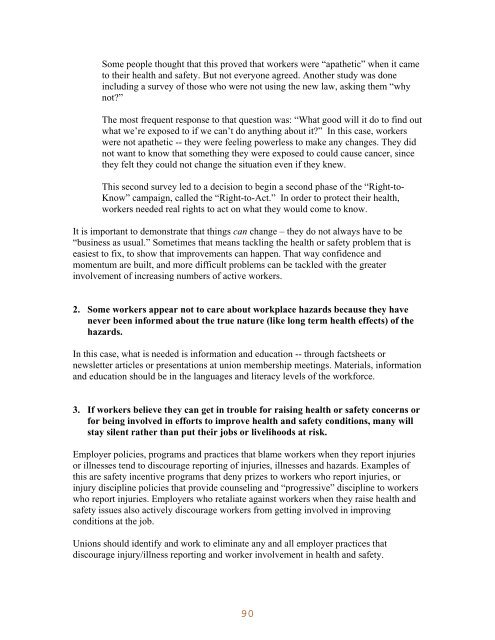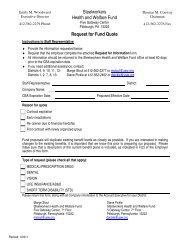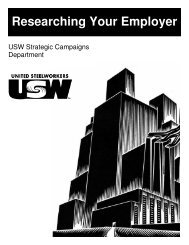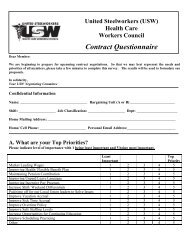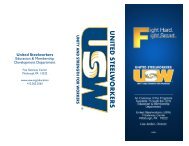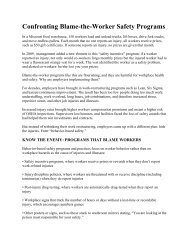Union Approach to Health and Safety: - United Steelworkers
Union Approach to Health and Safety: - United Steelworkers
Union Approach to Health and Safety: - United Steelworkers
You also want an ePaper? Increase the reach of your titles
YUMPU automatically turns print PDFs into web optimized ePapers that Google loves.
Some people thought that this proved that workers were “apathetic” when it came<br />
<strong>to</strong> their health <strong>and</strong> safety. But not everyone agreed. Another study was done<br />
including a survey of those who were not using the new law, asking them “why<br />
not?”<br />
The most frequent response <strong>to</strong> that question was: “What good will it do <strong>to</strong> find out<br />
what we’re exposed <strong>to</strong> if we can’t do anything about it?” In this case, workers<br />
were not apathetic -- they were feeling powerless <strong>to</strong> make any changes. They did<br />
not want <strong>to</strong> know that something they were exposed <strong>to</strong> could cause cancer, since<br />
they felt they could not change the situation even if they knew.<br />
This second survey led <strong>to</strong> a decision <strong>to</strong> begin a second phase of the “Right-<strong>to</strong>-<br />
Know” campaign, called the “Right-<strong>to</strong>-Act.” In order <strong>to</strong> protect their health,<br />
workers needed real rights <strong>to</strong> act on what they would come <strong>to</strong> know.<br />
It is important <strong>to</strong> demonstrate that things can change – they do not always have <strong>to</strong> be<br />
“business as usual.” Sometimes that means tackling the health or safety problem that is<br />
easiest <strong>to</strong> fix, <strong>to</strong> show that improvements can happen. That way confidence <strong>and</strong><br />
momentum are built, <strong>and</strong> more difficult problems can be tackled with the greater<br />
involvement of increasing numbers of active workers.<br />
2. Some workers appear not <strong>to</strong> care about workplace hazards because they have<br />
never been informed about the true nature (like long term health effects) of the<br />
hazards.<br />
In this case, what is needed is information <strong>and</strong> education -- through factsheets or<br />
newsletter articles or presentations at union membership meetings. Materials, information<br />
<strong>and</strong> education should be in the languages <strong>and</strong> literacy levels of the workforce.<br />
3. If workers believe they can get in trouble for raising health or safety concerns or<br />
for being involved in efforts <strong>to</strong> improve health <strong>and</strong> safety conditions, many will<br />
stay silent rather than put their jobs or livelihoods at risk.<br />
Employer policies, programs <strong>and</strong> practices that blame workers when they report injuries<br />
or illnesses tend <strong>to</strong> discourage reporting of injuries, illnesses <strong>and</strong> hazards. Examples of<br />
this are safety incentive programs that deny prizes <strong>to</strong> workers who report injuries, or<br />
injury discipline policies that provide counseling <strong>and</strong> “progressive” discipline <strong>to</strong> workers<br />
who report injuries. Employers who retaliate against workers when they raise health <strong>and</strong><br />
safety issues also actively discourage workers from getting involved in improving<br />
conditions at the job.<br />
<strong>Union</strong>s should identify <strong>and</strong> work <strong>to</strong> eliminate any <strong>and</strong> all employer practices that<br />
discourage injury/illness reporting <strong>and</strong> worker involvement in health <strong>and</strong> safety.


